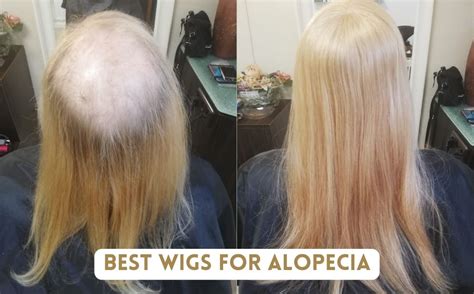Alopecia, a condition characterized by hair loss, can significantly impact a person’s self-esteem and well-being. Wigs, however, offer an effective and multifaceted solution to regain confidence and embrace their individuality.

Understanding Alopecia
The National Alopecia Areata Foundation estimates that over 7 million Americans suffer from alopecia. This condition can stem from a variety of factors, including autoimmune disorders, medical treatments, and genetics. Alopecia areata, the most common form, results in patchy or complete hair loss on the scalp.
Benefits of Wigs for Alopecia
Wigs provide numerous benefits for individuals with alopecia:
- Immediate Coverage: Wigs instantly conceal hair loss, restoring a sense of normalcy and confidence.
- Personal Expression: Wigs come in a wide range of styles, colors, and textures, allowing individuals to express their unique personality and regain their sense of self.
- Protection from Elements: Wigs shield the scalp from sun damage, cold temperatures, and environmental irritants.
- Emotional Support: Wigs can provide a sense of security and empowerment, reminding individuals that they are not defined by their hair loss.
Types of Wigs for Alopecia
- Synthetic Wigs: Made from synthetic fibers, these wigs are affordable, durable, and easy to maintain.
- Human Hair Wigs: Derived from ethically sourced human hair, these wigs offer natural-looking and long-lasting options.
- Monofilament Wigs: Featuring a fine mesh base, monofilament wigs allow for superior ventilation and comfort, making them ideal for sensitive scalps.
- Lace Front Wigs: With a lace or sheer fabric around the hairline, lace front wigs create a seamless and realistic look.
- Full Lace Wigs: Made entirely of lace or mesh, full lace wigs provide the most natural-looking and breathable option, but they require meticulous care.
Choosing the Right Wig
Selecting the right wig depends on individual preferences and specific needs:
- Material: Consider the durability, comfort, and ease of maintenance of different materials.
- Style: Choose a wig that complements your facial features, hair texture, and lifestyle.
- Color: Opt for a color that matches or complements your natural hair color or experiment with a bolder hue.
- Fit: Ensure the wig fits comfortably and securely, without causing irritation or discomfort.
Wig Care and Maintenance
Proper wig care is crucial for longevity and maintaining a flawless look:
- Regular Washing: Wash wigs according to the manufacturer’s instructions, using a gentle shampoo and conditioner.
- Brushing and Styling: Use a wig brush to gently detangle and style wigs, avoiding excessive heat.
- Storage: Store wigs on a wig stand or in a spacious box, away from heat and direct sunlight.
- Professional Maintenance: Consider scheduling regular appointments with a wig specialist for deep cleaning, reshaping, and any necessary repairs.
Strategies for Success
- Embracing Your Style: Own your wig and make it a part of your personal style, expressing your individuality through its versatility.
- Seeking Professional Help: Consult with a wig specialist or healthcare professional for guidance on wig selection, fitting, and maintenance.
- Finding a Support System: Connect with others with alopecia through support groups or online forums to share experiences and gain encouragement.
- Prioritizing Self-Care: Remember that your well-being comes first. Take time for self-care practices to manage stress and maintain a positive mindset.
Common Mistakes to Avoid
- Choosing the Wrong Color or Fit: Avoid wigs that do not match your natural hair color or fit properly, as this can compromise the realistic appearance.
- Over-Washing and Styling: Excessive washing and styling can damage the wig fibers, reducing its longevity. Follow the manufacturer’s care instructions meticulously.
- Storing the Wig Improperly: Improper storage can lead to tangles, matting, and damage. Store wigs in a dedicated wig stand or box.
- Neglecting Professional Maintenance: Regular professional maintenance is essential to ensure the wig’s longevity and maintain its optimal condition.
Wigs for Every Occassion | Table 1
| Occasion | Recommended Wig Type |
|---|---|
| Everyday Wear | Synthetic or Human Hair Wig |
| Special Events | Monofilament or Lace Front Wig |
| Physical Activities | Short, Low-Maintenance Wig |
| Hot Weather | Breathable Lace Wig |
| Cold Weather | Thick, Insulated Wig |
Wig Materials for Comfort | Table 2
| Material | Comfort Level |
|---|---|
| Synthetic Fibers | Low |
| Human Hair | Medium |
| Monofilament | High |
| Lace Front | High |
| Full Lace | Extreme |
Wig Care for Longevity | Table 3
| Task | Frequency |
|---|---|
| Washing | 1-2 times per month |
| Brushing | Daily |
| Styling | As needed |
| Deep Cleaning | Every 3-6 months |
Wig Safety Tips | Table 4
| Tip | Importance |
|---|---|
| Avoid Heat Damage | Prolonged heat can damage wig fibers. |
| Remove Before Sleeping | Wearing a wig while sleeping can cause headaches and discomfort. |
| Securely Fasten | Ensure the wig is fitted securely to prevent slipping or shifting. |
| Keep Away from Children | Children may accidentally pull or damage wigs. |
| Consult a Healthcare Professional | If experiencing scalp irritation or discomfort, seek professional advice. |
